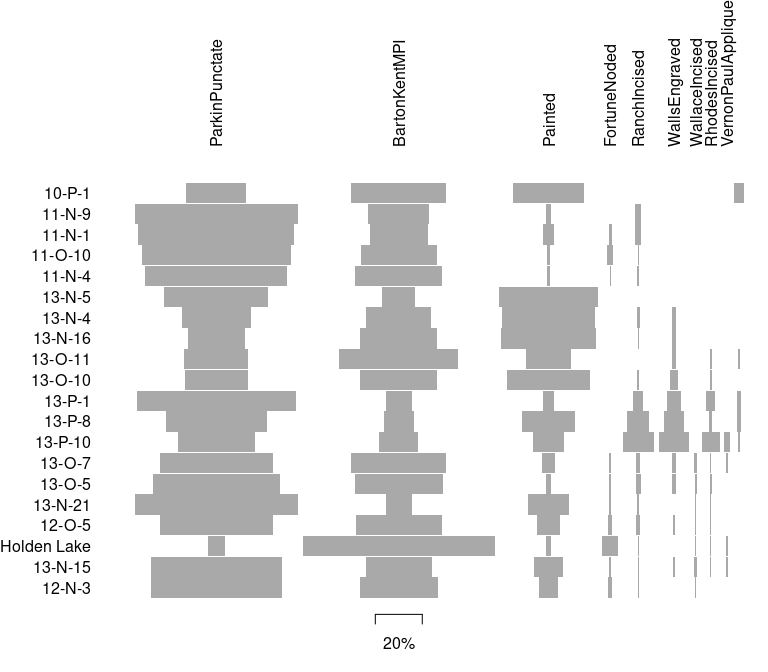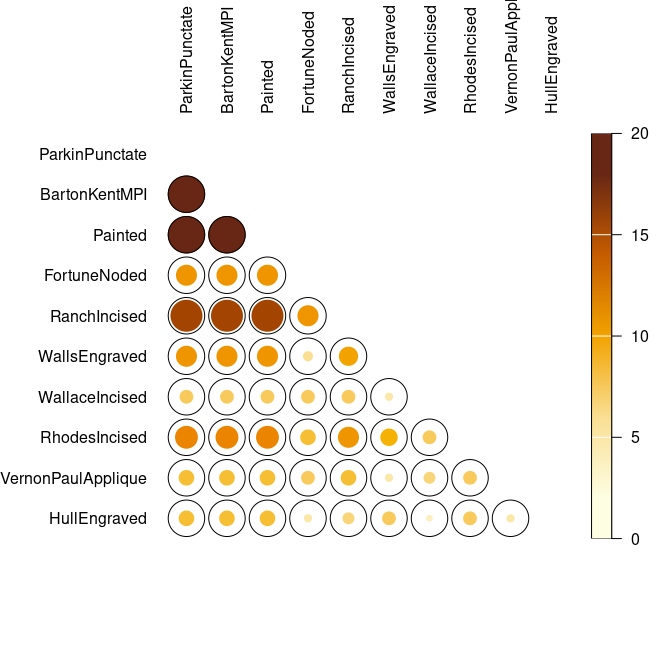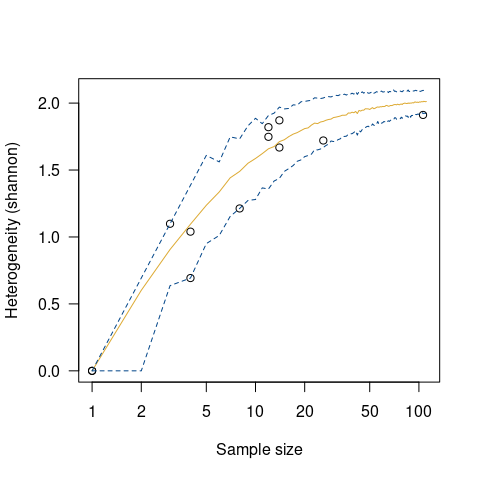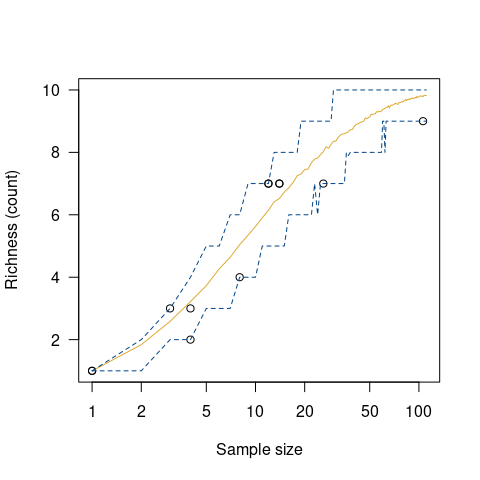An easy way to examine archaeological count data. This package
provides several tests and measures of diversity: heterogeneity and
evenness (Brillouin, Shannon, Simpson, etc.), richness and rarefaction
(Chao1, Chao2, ACE, ICE, etc.), turnover and similarity
(Brainerd-Robinson, etc.). It allows to easily visualize count data and
statistical thresholds: rank vs. abundance plots, heatmaps, Ford (1962)
and Bertin (1977) diagrams, etc. tabula provides
methods for:
This package provides translations of user-facing communications,
like messages, warnings and errors, and graphical elements (axis
labels). The preferred language is by default taken from the locale.
This can be overridden by setting of the environment variable
LANGUAGE (you only need to do this once per session):
Alroy, John. 2018. “Limits to Species Richness in Terrestrial
Communities.” Edited by Eric Seabloom.
Ecology Letters 21 (12):
1781–89.
https://doi.org/10.1111/ele.13152.
Baxter, M. J. 2001. “Methodological Issues in the Study of Assemblage
Diversity.”
American Antiquity 66 (4): 715–25.
https://doi.org/10.2307/2694184.
Berger, W. H., and F. L. Parker. 1970. “Diversity of Planktonic
Foraminifera in Deep Sea Sediments.”
Science 168 (3937):
1345–47.
https://doi.org/10.1126/science.168.3937.1345.
Bertin, Jacques. 1977. La graphique et le traitement graphique de
l’information. Nouvelle bibliothèque scientifique. Paris:
Flammarion.
Bobrowsky, P. T., and B. F. Ball. 1989. “The Theory and Mechanics of
Ecological Diversity in Archaeology.” In Quantifying Diversity in
Archaeology, edited by R. D. Leonard and G. T. Jones, 4–12. New
Directions in Archaeology. Cambridge: Cambridge University Press.
Boone, James L. 1987. “Defining and Measuring Midden Catchment.”
American Antiquity 52 (2): 336–45.
https://doi.org/10.2307/281785.
Bowman, K. O., K. Hutcheson, E. P. Odum, and L. R. Shenton. 1971.
“Comments on the Distribution of Indices of Diversity.” In
Statistical Ecology, edited by E. C. Patil, E. C. Pielou, and
W. E. Waters, 3:315–66. University Park, PA: Pennsylvania State
University Press.
Brainerd, G. W. 1951. “The Place of Chronological Ordering in
Archaeological Analysis.”
American Antiquity 16 (4): 301–13.
https://doi.org/10.2307/276979.
Bray, J. R., and J. T. Curtis. 1957. “An Ordination of the Upland Forest
Communities of Southern Wisconsin.”
Ecological Monographs 27
(4): 325–49.
https://doi.org/10.2307/1942268.
Brillouin, L. 1956. Science and Information Theory. New York:
Academic Press.
Buzas, M. A., and L.-A. C. Hayek. 1998. “SHE Analysis for Biofacies
Identification.” Journal of Foraminiferal Research 28 (3):
233–39.
Caprariis, P. de, R. H. Lindemann, and C. M. Collins. 1976. “A Method
for Determining Optimum Sample Size in Species Diversity Studies.”
Journal of the International Association for Mathematical
Geology 8 (5): 575–81.
https://doi.org/10.1007/BF01042995.
Chao, A. 1984. “Nonparametric Estimation of the Number of Classes in a
Population.” Scandinavian Journal of Statistics 11 (4): 265–70.
———. 1987. “Estimating the Population Size for Capture Recapture Data
with Unequal Catchability.”
Biometrics 43 (4): 783–91.
https://doi.org/10.2307/2531532.
Chao, A., and C.-H. Chiu. 2016. “Species Richness: Estimation and
Comparison.” In
Wiley StatsRef: Statistics Reference Online,
edited by N. Balakrishnan, T. Colton, B. Everitt, W. Piegorsch, F.
Ruggeri, and J. L. Teugels, 1–26. Chichester, UK: John Wiley & Sons,
Ltd.
https://doi.org/10.1002/9781118445112.stat03432.pub2.
Chao, A., and S.-M. Lee. 1992. “Estimating the Number of Classes Via
Sample Coverage.”
Journal of the American Statistical
Association 87 (417): 210–17.
https://doi.org/10.1080/01621459.1992.10475194.
Chiu, C.-H., Y.-T. Wang, B. A. Walther, and A. Chao. 2014. “An Improved
Nonparametric Lower Bound of Species Richness Via a Modified Good-Turing
Frequency Formula.”
Biometrics 70 (3): 671–82.
https://doi.org/10.1111/biom.12200.
Cody, M. L. 1975. “Towards a Theory of Continental Species Diversity:
Bird Distributions Over Mediterranean Habitat Gradients.” In Ecology
and Evolution of Communities, edited by M. L. Cody and J. M.
Diamond, 214–57. Cambridge, MA: Harvard University Press.
Conkey, Margaret W. 1980. “The Identification of Prehistoric
Hunter-Gatherer Aggregation Sites: The Case of Altamira.” Current
Anthropology 21 (5): 609–30.
Desachy, B. 2004. “Le sériographe EPPM: un outil informatisé de
sériation graphique pour tableaux de comptages.”
Revue archéologique
de Picardie 3 (1): 39–56.
https://doi.org/10.3406/pica.2004.2396.
Dice, L. R., and H. J. Leraas. 1936. “A Graphic Method for Comparing
Several Sets of Measurements.” Contributions from the Laboratory of
Vertebrate Genetics 3: 1–3.
Dice, Lee R. 1945. “Measures of the Amount of Ecologic Association
Between Species.”
Ecology 26 (3): 297–302.
https://doi.org/10.2307/1932409.
Eren, Metin I., Anne Chao, Wen-Han Hwang, and Robert K. Colwell. 2012.
“Estimating the Richness of a Population When the Maximum Number of
Classes Is Fixed: A Nonparametric Solution to an Archaeological
Problem.” Edited by Alex Mesoudi.
PLoS ONE 7 (5): e34179.
https://doi.org/10.1371/journal.pone.0034179.
Fisher, R. A., A. S. Corbet, and C. B. Williams. 1943. “The Relation
Between the Number of Species and the Number of Individuals in a Random
Sample of an Animal Population.”
The Journal of Animal Ecology
12 (1): 42.
https://doi.org/10.2307/1411.
Ford, J. A. 1962. A Quantitative Method for Deriving Cultural
Chronology. Technical Manual 1. Washington, DC: Pan American Union.
Frerebeau, Nicolas. 2019. “Tabula: An R Package for Analysis, Seriation,
and Visualization of Archaeological Count Data.”
Journal of Open
Source Software 4 (44): 1821.
https://doi.org/10.21105/joss.01821.
Gleason, H. A. 1922. “On the Relation Between Species and Area.”
Ecology 3 (2): 158–62.
https://doi.org/10.2307/1929150.
Gotelli, Nicholas J., and Robert K. Colwell. 2011. “Estimating Species
Richness.” In Biological Diversity: Frontiers in Measurement and
Assessment, edited by Anne E. Magurran and Brian J. McGill, 39–54.
Oxford: Oxford University Press.
Hayek, L.-A. C., and M. A. Buzas. 2010. Surveying Natural
Populations: Quantitative Tools for Assessing Biodiversity. Second
edition. New York: Columbia University Press.
Horn, Henry S. 1966. “Measurement of”Overlap” in Comparative Ecological
Studies.”
The American Naturalist 100 (914): 419–24.
https://doi.org/10.1086/282436.
Hubbs, C. L., and C. Hubbs. 1953. “An Improved Graphical Analysis and
Comparison of Series of Samples.”
Systematic Biology 2 (2):
49–56.
https://doi.org/10.2307/sysbio/2.2.49.
Huntley, Deborah L. 2004. “Interaction, Boundaries, and Identities: A
Multiscalar Approach to the Organizational Scale of Pueblo IV Zuni
Society.” PhD thesis, Arizona State University.
———. 2008.
Ancestral Zuni Glaze-Decorated Pottery: Viewing Pueblo IV
Regional Organization Through Ceramic Production and Exchange.
Anthropological Papers of the University of Arizona 72. Tucson:
University of Arizona Press.
https://doi.org/10.2307/j.ctv2ngx5n8.
Hurlbert, S. H. 1971. “The Nonconcept of Species Diversity: A Critique
and Alternative Parameters.”
Ecology 52 (4): 577–86.
https://doi.org/10.2307/1934145.
Hutcheson, K. 1970. “A Test for Comparing Diversity Based on the Shannon
Formula.”
Journal of Theoretical Biology 29 (1): 151–54.
https://doi.org/10.1016/0022-5193(70)90124-4.
Kilburn, P. D. 1966. “Analysis of the Species-Area Relation.”
Ecology 47 (5): 831–43.
https://doi.org/10.2307/1934269.
Kintigh, K. 2006. “Ceramic Dating and Type Associations.” In
Managing Archaeological Data: Essays in Honor of Sylvia W.
Gaines, edited by J. Hantman and R. Most, 17–26. Anthropological
Research Paper 57. Tempe, AZ: Arizona State University.
https://doi.org/10.6067/XCV8J38QSS.
Kintigh, K. W. 1984. “Measuring Archaeological Diversity by Comparison
with Simulated Assemblages.”
American Antiquity 49 (1): 44–54.
https://doi.org/10.2307/280511.
———. 1989. “Sample Size, Significance, and Measures of Diversity.” In
Quantifying Diversity in Archaeology, edited by R. D. Leonard
and G. T. Jones, 25–36. New Directions in Archaeology. Cambridge:
Cambridge University Press.
Laxton, R. R. 1978. “The Measure of Diversity.”
Journal of
Theoretical Biology 70 (1): 51–67.
https://doi.org/10.1016/0022-5193(78)90302-8.
Leonard, Robert D., and George T. Jones, eds. 1989. Quantifying
Diversity in Archaeology. New Directions in Archaeology. Cambridge:
Cambridge University Press.
Macarthur, R. H. 1965. “Patterns of Species Diversity.”
Biological
Reviews 40 (4): 510–33.
https://doi.org/10.1111/j.1469-185X.1965.tb00815.x.
Magurran, A. E. 1988. Ecological Diversity and Its Measurement.
Princeton, NJ: Princeton University Press.
Magurran, A. E., and B. J. McGill, eds. 2011. Biological Diversity:
Frontiers in Measurement and Assessment. Oxford: Oxford University
Press.
Margalef, R. 1958. “Information Theory in Ecology.” General
Systems 3: 36–71.
McIntosh, R. P. 1967. “An Index of Diversity and the Relation of Certain
Concepts to Diversity.”
Ecology 48 (3): 392–404.
https://doi.org/10.2307/1932674.
Menhinick, E. F. 1964. “A Comparison of Some Species-Individuals
Diversity Indices Applied to Samples of Field Insects.”
Ecology
45 (4): 859–61.
https://doi.org/10.2307/1934933.
Moreno, C. E., and P. Rodríguez. 2010. “A Consistent Terminology for
Quantifying Species Diversity?”
Oecologia 163 (2): 279–82.
https://doi.org/10.1007/s00442-010-1591-7.
Mosrisita, Masaaki. 1959. “Measuring of Interspecific Association and
Similarity Between Communities.” Memoirs of the Faculty of Science,
Kyushu University, Series E, 3: 65–80.
Odum, H. T., J. E. Cantlon, and L. S. Kornicker. 1960. “An
Organizational Hierarchy Postulate for the Interpretation of
Species-Individual Distributions, Species Entropy, Ecosystem Evolution,
and the Meaning of a Species-Variety Index.”
Ecology 41 (2):
395–95.
https://doi.org/10.2307/1930248.
Peet, R. K. 1974. “The Measurement of Species Diversity.”
Annual
Review of Ecology and Systematics 5 (1): 285–307.
https://doi.org/10.1146/annurev.es.05.110174.001441.
Pielou, E. C. 1975. Ecological Diversity. New York: Wiley.
Preston, F. W. 1948. “The Commonness, and Rarity, of Species.”
Ecology 29 (3): 254–83.
https://doi.org/10.2307/1930989.
———. 1962a. “The Canonical Distribution of Commonness and Rarity: Part
I.”
Ecology 43 (2): 185.
https://doi.org/10.2307/1931976.
———. 1962b. “The Canonical Distribution of Commonness and Rarity: Part
II.”
Ecology 43 (3): 410–32.
https://doi.org/10.2307/1933371.
Robinson, W. S. 1951. “A Method for Chronologically Ordering
Archaeological Deposits.”
American Antiquity 16 (4): 293–301.
https://doi.org/10.2307/276978.
Routledge, R. D. 1977. “On Whittaker’s Components of Diversity.”
Ecology 58 (5): 1120–27.
https://doi.org/10.2307/1936932.
Sander, H. L. 1968. “Marine Benthic Diversity: A Comparative Study.”
The American Naturalist 102 (925): 243–82.
https://www.jstor.org/stable/2459027.
Shannon, C. E. 1948. “A Mathematical Theory of Communication.”
The
Bell System Technical Journal 27: 379–423.
https://doi.org/10.1002/j.1538-7305.1948.tb01338.x.
Simpson, E. H. 1949. “Measurement of Diversity.”
Nature 163
(4148): 688–88.
https://doi.org/10.1038/163688a0.
Simpson, Georges Gaylord, Anne Roe, and Richard C. Lewontin. 1960.
Quantitative Zoology. Édition revue. New York: Harcourt, Brace
and Company.
Sorensen, Thorvald. 1948. “A Method of Establishing Groups of Equal
Amplitude in Plant Sociology Based on Similarity of Species Content and
Its Application to Analyses of the Vegetation on Danish Commons.”
Kongelige Danske Videnskabernes Selskab 5 (4): 1–34.
Tóthmérész, B. 1995. “Comparison of Different Methods for Diversity
Ordering.”
Journal of Vegetation Science 6 (2): 283–90.
https://doi.org/10.2307/3236223.
Whittaker, R. H. 1960. “Vegetation of the Siskiyou Mountains, Oregon and
California.”
Ecological Monographs 30 (3): 279–338.
https://doi.org/10.2307/1943563.
Wilson, M. V., and A. Shmida. 1984. “Measuring Beta Diversity with
Presence-Absence Data.”
The Journal of Ecology 72 (3): 1055–64.
https://doi.org/10.2307/2259551.





